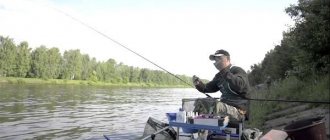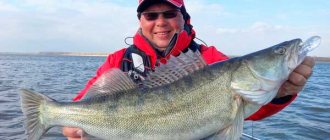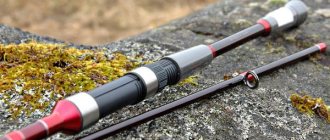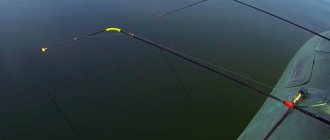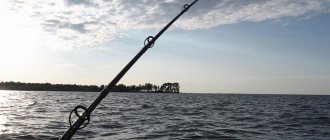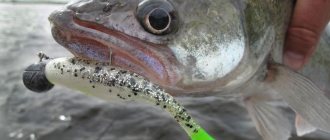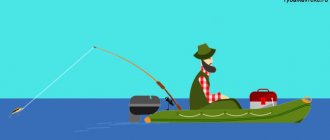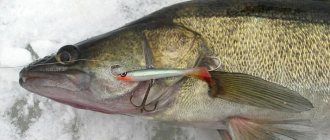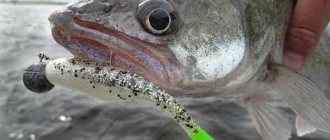Most anglers believe that it is better to catch pike perch using a jig. But in reality, the most effective way to catch walleye is by trolling. Its main advantage is a quick check of the reservoir for the presence of an active predator. If we compare trolling for pike perch with jig and twitch fishing, it is not as dependent on weather conditions as other fishing methods.
Basic requirements for a trolling rod
Trolling fishing for pike perch with a spinning rod places a number of demands on the material from which the product is made. There are also special requirements for the test, length and action of the rod.
- Glass and carbon fiber are used to make the fishing rod. Compared to carbon fiber, fiberglass products have a lower degree of sensitivity and weigh more. This is a budget option with a low price. Spinning rods made of carbon are the most sensitive and therefore are very popular among anglers. Often glass and carbon fiber are combined. The resulting product has average technical characteristics and has an affordable price.
- For beginners who have never trolled, it is better to choose a rod length up to 2.4 m. This is the most suitable size. It is difficult to maneuver in a small boat with a spinning rod that is too long. Experienced fishermen use rods longer than 2.4 m, because... They are convenient to use on 2-3 rods at the same time.
- A rod with a slow and medium action is not suitable for trolling. The best action is fast and super fast. On the product, the ultra-fast action is marked Extra fast or FF, and the fast action is marked with the letter F.
- The rod test is selected depending on the conditions of the reservoir. Spinning with a small dough is suitable for shallow rivers with moderate currents. If the river is large and deep, and the current is fast, then a large, heavy bait is required. Accordingly, the spinning rod should hold it. Therefore, for such rivers, a product with an upper test limit of more than 100 g is chosen.
Tackle for trolling zander
Considering the size of the trophy and the possibility of fishing in “strong” places, it is necessary to acquire durable gear. Large pike perch often stands behind snags and fallen trees, therefore, hooks cannot be avoided.
Selecting a spinning rod
The requirements for a rod for this fishing method are low and come down mainly to power reserves. It is recommended to take a stick up to 2.4 meters long. This spinning rod is quite convenient to maneuver when fishing, and there is no need for long casts. Rods with fast and super-fast action perform somewhat better, although this parameter is not very important. If hunting for a fanged fish takes place on a pond or river with a small current, a large test of the rod is not necessary. At depth and strong currents, you should take a spinning rod with an upper test limit of 100 grams or more.
A bait reel is a powerful inertial option for hard work with a trophy. If there is a counter on them, then it’s like a bonus that displays how many meters of cord have been lowered. Nylon fishing line is inconvenient to use in trolling due to its strong stretchability. A braided cord works much better here.
Wobblers for trolling
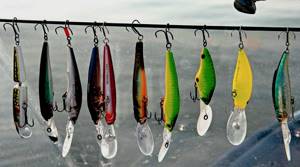
Often, beginning trollers try to take expensive wobblers. In my opinion, such a measure is not at all necessary. There are many affordable but decent options from Asian manufacturers.
When choosing a wobbler for pike perch, pay attention to:
- Maximum depth. Considering that the fanged one almost always hunts in the bottom layer, the bait must be placed near the bottom.
- Size and shape. Pike perch prefers narrow-bodied baits. Running size 80-100 mm.
- Colors. There is no clear pattern here. Sometimes realistically colored wobblers “shoot out”, sometimes bright “acid” ones.
Recommended reading: How to catch a large crucian carp
Catching pike perch by trolling involves constant experimentation.
Note! When trolling, the bait is constantly in action. The wobbler must have stable play at different speeds. In some cases, the wiring speed reaches 10 kilometers per hour.
Coil selection
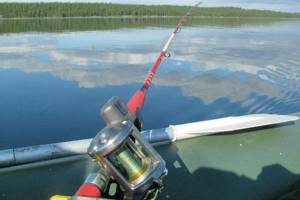
To catch pike perch by trolling, you need to choose a suitable reel that will withstand the necessary loads and cope with landing the fish. The main property it should have is power. Otherwise, due to heavy loads, the coil will quickly break. If the baits are lightweight and the depth of the reservoir is shallow, then you can use simple lightweight models. The most convenient option is a multiplier reel . It is equipped with a counter that accurately displays the length of the fishing line.
Installation of trolling gear
Depending on the conditions of the reservoirs in which fishing is planned, the gear for catching pike perch must be durable. Because uneven surfaces, underwater snags and stones for gear are dangerous for hooking. Fishing rod equipment:
- Choose a short fishing rod with a fast action.
- It is also equipped with a multiplier reel and a metal leash. It is better to use a titanium or Kevlar leash. This flexible and thin product looks like fishing line and is particularly durable. Pike perch is a toothy fish and easily bites the fishing line during attacks. But with a metal leash it will be difficult to do this.
- Some Chinese fake wobblers cannot cope with strong currents and are unable to sink to the bottom on their own. Therefore, the fishing rod is additionally equipped with a sinker. The simplest deepening agent is sinker. It has a flat shape and is mounted at an angle.
To make the catch more effective, install a drop shot. This is a retractable leash, which consists of a fishing line with an end weight, a metal leash and a sinker. The end load is chosen in the shape of a pear or ball. To give the tackle flexibility, the leash is tied to a triple swivel. Having retreated 50 cm upward, sinkers are tied to it. Thanks to this equipment, the leash will not twist while moving. The bouncer has a more rigid design. It looks like a retractable leash. In this rig, the wobbler is attached to a spring wire.
Choosing a place to catch pike perch by trolling
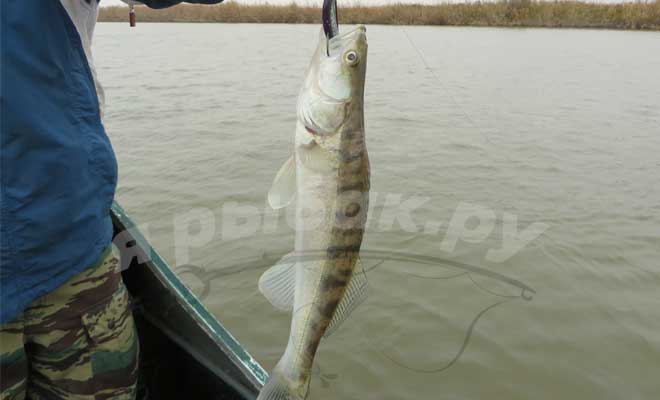
Each type of fish has its own character, and if you do not take into account the behavior of pike perch, you may be left without a catch. Newbies often suffer from a lack of information about their behavior, returning home empty-handed. You need to know how to choose the right place to get a big catch. Pond conditions:
- The bottom in places for catching pike perch should have a complex, uneven topography. The fish likes to appear in algae thickets, near deep holes and rock ledges.
- The fish does not like standing water, so it is more often found in rivers with strong currents. You won't be able to catch it in the lake.
- Individuals of various sizes like to swim into areas with vegetation at night, but do not stay there for long.
- You can catch pike perch near the shore or in the shallows only at night. At this time they are looking for food, so they swim close to the shore.
You can increase your catch using an echo sounder, which is sold in any specialized store. It has an affordable price and every fisherman can afford to buy it.
Catching pike perch in the fall with a jig
Well, where would we be without a jig when it comes to catching pike perch! Especially in autumn, when fish prefer depth. If the relief of the reservoir makes it easy to read the depressions and deep-sea edges that pike perch like so much in the fall, then heavy lead jigs will help you make an accurate cast without any sideways movements. And then it’s a matter of technique - pulsating movements attract the attention of pike perch - the so-called stepped retrieve is most effective for bottom fishing. Particularly large individuals of pike perch prefer jigs with a flexible rubber bait. But other types of bait cannot be discounted. Jigging spoons can be very effective when catching schooling walleye.
Wobblers for trolling for pike perch
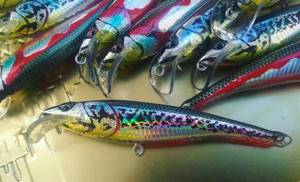
Wobblers for trolling fishing are selected according to their depth of immersion and stability of play. Size and color also play an important role:
- Burying depth. Pike perch hunts for prey at the very bottom: in places with snags or on uneven terrain. He lies in wait for his prey near the exit from the pits. Given this feature, the immersion depth of a trolling wobbler should be more than 2 meters. A smaller working depth cannot be used. The shape and size of the blade will help you visually determine the working depth.
- Lure size. To catch big fish, the pike perch bait must be large. In addition, the fisherman does not know exactly where the fish are congregating. A large bait creates a lot of noise and vibrations, so it can attract fish from a long distance.
- Wobbler color. If the weather is cloudy and the water is cloudy, then you should use models with bright colors. Natural colors are used during sunny weather and in clear water. Due to the fact that fish behave differently in different bodies of water, you can experiment and use bait of any color.
An important condition when trolling is the stability of the wobbler. We can't let the game get disrupted. Otherwise, the fish will not notice the wobbler, which will constantly fall to the side. In addition, because of this, nothing will fall on the neighboring rod with the working bait. To avoid game instability, you need to buy products from trusted manufacturers.
Trolling technique for catching pike perch
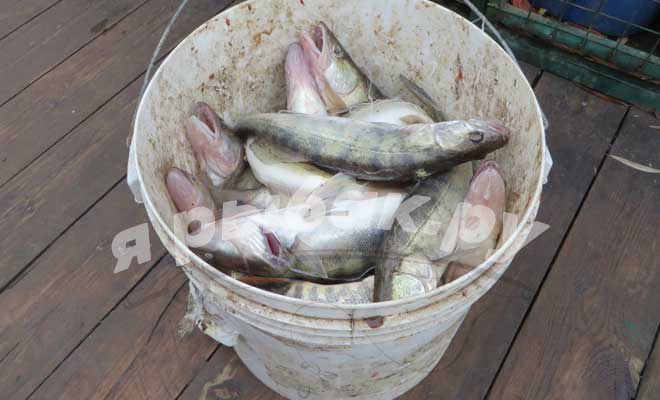
To choose tactics for catching pike perch by trolling, first examine the reservoir. This can be done using an echo sounder; it will help you select the optimal depth and locate places where fish accumulate. Fishing technique:
- All the necessary equipment is placed in the boat and sailed 10 m from the shore. Then the spinning rod with bait is cast, and the rod is attached to the holder.
- You need to move along the shore by boat at a speed of up to 2-3 km/h. Otherwise, if the speed is high, the bait will go to the bottom, and if the speed is too low, it will settle at an average depth. When fishing for pike perch, the optimal diving depth should be more than 3 m.
- The speed of the boat is chosen depending on weather conditions. In spring, fish can be caught at a speed of 2 to 4 km/h. In the fall, trolling for walleye is done at a slow speed, but experiments can be done.
- In order not to miss the prey, hooking is done with sharp movements on a large scale.
- If you install several spinning rods with different wobblers, the chance of catching will increase by 2 times.
- To prevent the wires of the baits from getting tangled with each other, casting is done at different distances from each other. The approximate distance varies from 20 to 50 m.
Summer trolling for pike perch differs from the rest in its good bite. Especially in early June, when spawning ends. During this period, the fish are hungry and can be caught with small artificial baits. Professional fishermen advise catching pike perch by trolling at night in hot weather (July and August). During this period, the fish becomes inactive.
Requirements for the craft
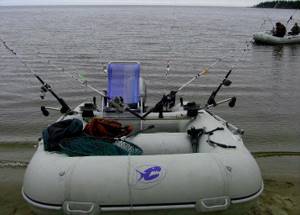
So, about trolling boats. What should they be:
- Boat. The most comfortable boat. For the most part, the boats are well seaworthy and allow you to load a large number of things. The only negative is the weight and dimensions.
- Inflatable motor boat. Its feature is mobility. Boats made of PVC material are compact. Models with a keel are quite stable on the water. Inflatable boats are relatively easy to maintain and more affordable. The running dimensions of the trolling vessel are 3.5-4 meters.
Motor: Today, most use foreign-made motors. Operation is simple, maintenance is not annoying. When purchasing a motor, you need to remember that the internal combustion engine has four strokes and is quieter than a two-stroke engine. Its fuel consumption is lower, but the engine itself is slightly more massive than a two-stroke and the price is higher.
On a note! If you don’t walk far on water, you can use power units with a capacity of 2-5 l/hp. If you plan to move 7-10 km from the anchorage, it is better to use a powerful engine that can bring the ship to planing in any weather.
On a PCV boat with two passengers, a motor with a power of 8-15 horses is often installed. This set is considered universal.
For trolling in small bodies of water, it is convenient to use a compact electric motor. The boat under it moves almost silently, which allows you to quietly approach promising places.
We recommend reading: Rotan firebrand
